Related Research Articles
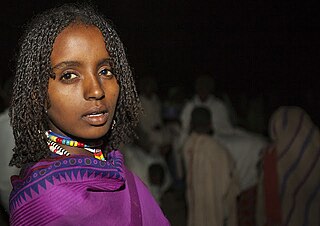
The Oromo people are a Cushitic ethnic group native to the Oromia region of Ethiopia and parts of Northern Kenya. They speak the Oromo language, which is part of the Cushitic branch of the Afroasiatic language family. They are one of the largest ethnic groups in Ethiopia. According to the last Ethiopian census of 2007, the Oromo numbered 25,488,344 people or 34.5% of the Ethiopian population. Recent estimates have the Oromo comprising 45,000,000 people, or 35.8% of the total Ethiopian population estimated at 116,000,000.
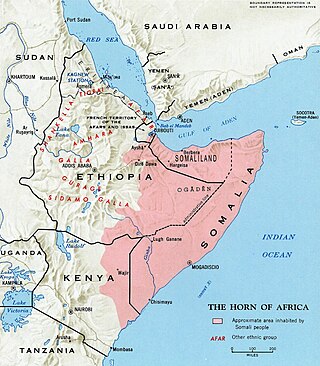
Somali is an Afroasiatic language belonging to the Cushitic branch. It is spoken as a mother tongue by Somalis in Greater Somalia and the Somali diaspora. Somali is an official language in Somalia and Ethiopia, and a national language in Djibouti as well as in northeastern Kenya. The Somali language is written officially with the Latin alphabet although the Arabic alphabet and several Somali scripts like Osmanya, Kaddare and the Borama script are informally used.

French Somaliland was a French colony in the Horn of Africa. It existed between 1884 and 1967, at which time it became the French Territory of the Afars and the Issas. The Republic of Djibouti is its legal successor state.
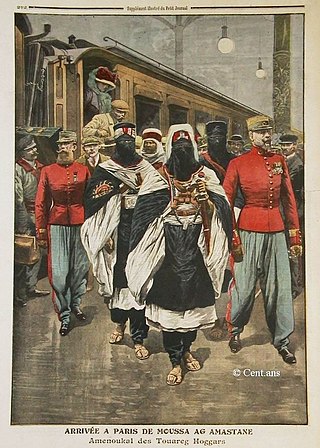
Musa Ag Amastan (1867–1920) was the Chief (Amenokal) of the Kel Ahaggar Tuareg from 1905 to 1920. Based in the Ahaggar, he formed part of the Kel Ghela.

The Rendille are a Cushitic ethnic group inhabiting the Eastern Province of Kenya.

The Marehan is a Somali clan, which is part of one of the largest Somali clan families, the Darod.
The Yibir, also referred to as the Yibbir, the Yebir, or the Yibro, are a caste of Somali people. They have traditionally been endogamous. Their hereditary occupations have been magic making, leather work, the dispensing of traditional medicine and the making of amulets. They belong to the Sab clan and sometimes referred to as a minority clan, they perform menial tasks.
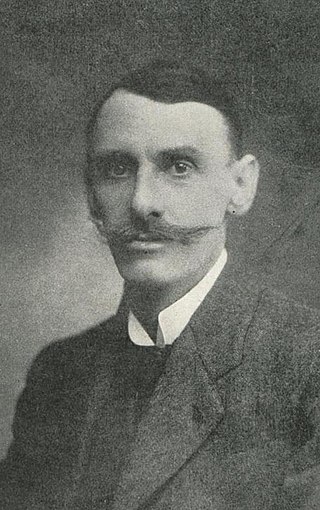
Maurice Delafosse was a French ethnographer and colonial official who also worked in the field of the languages of Africa. In a review of his daughter's biography of him he was described as "one of the most outstanding French colonial administrators and ethnologists of his time."
The Aweer are a Cushitic-speaking ethnic group inhabiting the Coast Province in southeastern Kenya. They are indigenous foragers, traditionally subsisting on hunting, gathering, and collecting honey.

The Konso, also known as the Xonsita, are a Lowland East Cushitic-speaking ethnic group primarily inhabiting south-western Ethiopia.

Somali mythology covers the beliefs, myths, legends and folk tales circulating in Somali society that were passed down to new generations in a timeline spanning several millennia in Somalia and Djibouti dating back 6000 years ago. Many of the things that constitute monotheistic Somali mythology today are traditions whose accuracy have faded away with time or have been gentrified considerably with the coming of Islam to the Horn of Africa.

The Harari people are a Semitic-speaking ethnic group which inhabits the Horn of Africa. Members of this ethnic group traditionally reside in the walled city of Harar, simply called Gēy "the City" in Harari, situated in the Harari Region of eastern Ethiopia. They speak the Harari language, a member of the South Ethiopic grouping within the Semitic subfamily of the Afroasiatic languages.
The predominant religion in Somalia is Islam, with tiny minorities of Christians, traditional African religions and others.
The Harla, also known as Harala, Haralla are an ethnic group that once inhabited Ethiopia, Somalia, and Djibouti. They spoke the now-extinct Harla language, which belonged to either the Cushitic or Semitic branches of the Afroasiatic family.
Yusuf bin Ahmad al-Kawneyn, popularly known as Aw Barkhadle or Yusuf Al Kownayn, was an Islamic scholar and traveler based in Zeila. Based on reference to Yusuf Al Kawneyn in the Harar manuscripts, Dr. Enrico Cerulli.

The El Molo, also known as Elmolo, Dehes, Fura-Pawa and Ldes, are an ethnic group mainly inhabiting the northern Eastern Province of Kenya. They historically spoke the El Molo language as a mother tongue, an Afro-Asiatic language of the Cushitic branch, and now most El Molo speak Samburu.
The Bursuuk or also written as Barsuk, Barsuq and Barsoub is a clan belonging to Madahweyne sub-clan of the Dir clan family. They largely live in Ethiopia, in the Somali Region, especially around the ancient city of Harar and between the city and Jigjiga.
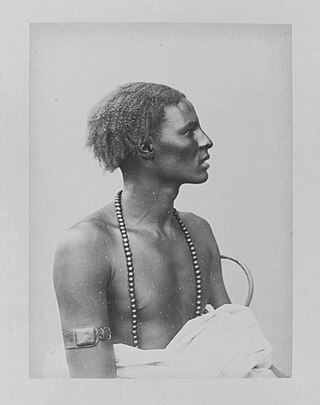
The Tomal, also known as Tumal or Tumaal, is an artisanal caste among Somali people. Their traditional hereditary occupation has been as smiths and leather production, and they have been endogamous.
The Jidwaq is a major subclan, part of one of the largest Somali clans families, the Absame Darod. Jidwaq are well known for their conquests in Abyssinia during the 1500s they played a very prominent role in the Adal Sultanate. They are famous for bringing the largest army and were very loyal to Imam Ahmad. Jidwaq have produced notable generals such as Ahmed Girri Bin Hussein who was the right hand man of Ahmad ibn Ibrahim al-Ghazi.
Waaqeffanna is an ethnic religion indigenous to the Oromo people in the Horn of Africa. The word Waaqeffanna is derived from Waaq which is the ancient name for the Creator in the Cushitic languages of both the Oromo people and Somali people in the Horn of Africa. The followers of the Waaqeffanna religion are called Waaqeffataa and they believe in the supreme being Waaqa Tokkicha. It is estimated that about 3% of the Oromo population, which is 1,095,000 Oromos, in present day Ethiopia actively practice this religion. Some put the number around 300,000, depending on how many subsets of the religion one includes. This number is still up for debate by many African religious scholars.
References
- ↑ Thomas, Douglas; Alanamu, Temilola (2018-12-31). African Religions: Beliefs and Practices through History. ABC-CLIO. ISBN 978-1-61069-752-1.
- 1 2 Mohamed Diriye Abdullahi, Culture and Customs of Somalia, (Greenwood Publishing Group: 2001), p.65.
- ↑ Samatar, Said S. "Unhappy masses and the challenge of political Islam in the Horn of Africa". Horn of Africa. 20: 1–10.
- ↑ Ali, Aweis (2021). Understanding the Somali Church. Kenya Projects Organization [KENPRO]. ISBN 978-9914-9929-2-2.
- ↑ Adam, Hussein Mohamed; Ford, Richard (1997). Mending Rips in the Sky: Options for Somali Communities in the 21st Century. Red Sea Press. p. 126. ISBN 978-1-56902-073-9.
- ↑ Sasse, Hans-Jürgen (1982). "Consonant Phonemes of Proto-East Cushitic". Afro-Asiatic Linguistics. 7 (1): 42.
- ↑ Sasse, Hans-Jürgen. An Etymological Dictionary of Burji. Hamburg: Helmut Buske. p. 186.
- ↑ Lewis, I. M. (1998). Saints and Somalis: Popular Islam in a Clan-based Society. The Red Sea Press. p. 136. ISBN 978-1-56902-103-3.
- ↑ Lewis, I. M. (1998). Saints and Somalis: Popular Islam in a Clan-based Society. The Red Sea Press. p. 137. ISBN 978-1-56902-103-3.
- ↑ Mohamed Diriye Abdullahi, Culture and Customs of Somalia, (Greenwood Publishing Group: 2001), p.65.
- ↑ Lewis, I. M. (1956). "Sufism in Someliland: A Study in Tribal Islam–II". Bulletin of the School of Oriental and African Studies. 18 (1): 145–160. ISSN 1474-0699.
- ↑ Samatar, S S. (2002). "Unhappy masses and the challenge of political Islam in the Horn of Africa". catalogue.leidenuniv.nl. pp. 1–10.
- ↑ SearchTruth. "Search Quran - waq in Quran القران الكريم in English translation by Mohsin Khan". SearchTruth.com.
Chapter: Ar-Ra'd. Verses: 13:34 and 13:37.
- ↑ Mohamed-Abdi, Mohamed (1992). Histoire des croyances en Somalie : Religions traditionnelles et religions du Livre. Annales Littéraires de l'Université de Besançon. Vol. 465. doi:10.3406/ista.1992.2545. ISBN 978-2-251-60465-7.
- ↑ Ibn Arabi (1240). كِتَابُ الفُتُوحَاتِ المَكِّيَّة[The Meccan Revelations] (in Arabic). p. 1123.
- ↑ Lewis, I. M. (2017-02-03). Islam in Tropical Africa. Routledge. ISBN 978-1-315-31139-5.
- ↑ Mire, Sada (2020-02-05). Divine Fertility: The Continuity in Transformation of an Ideology of Sacred Kinship in Northeast Africa. Routledge. ISBN 978-0-429-76924-5.